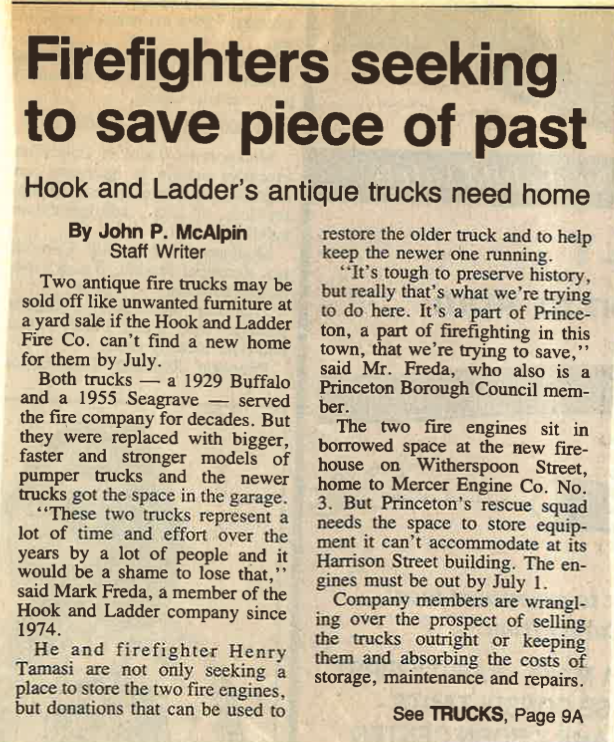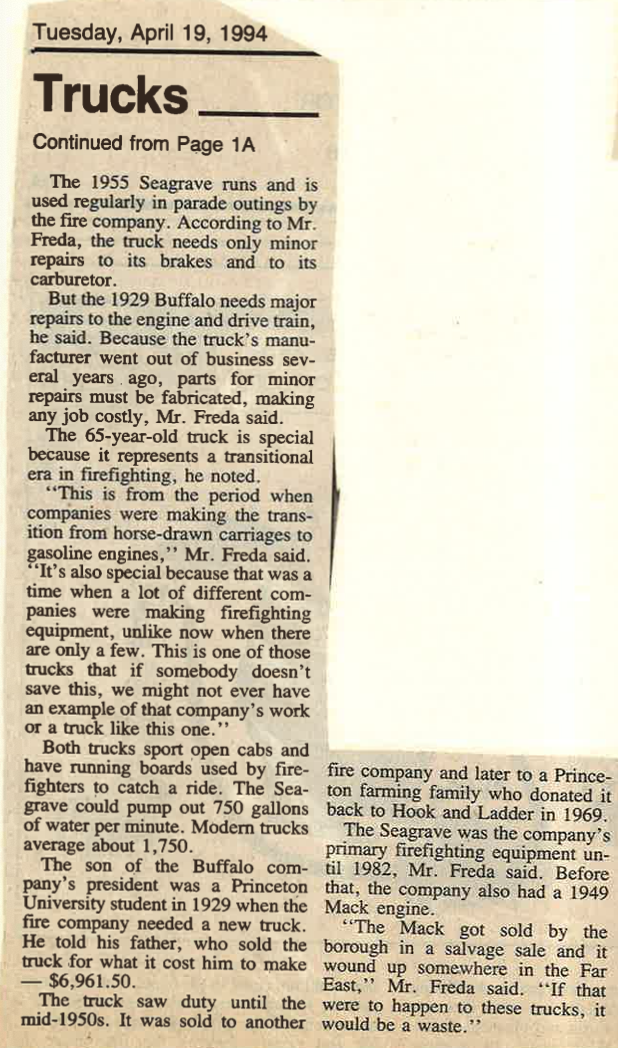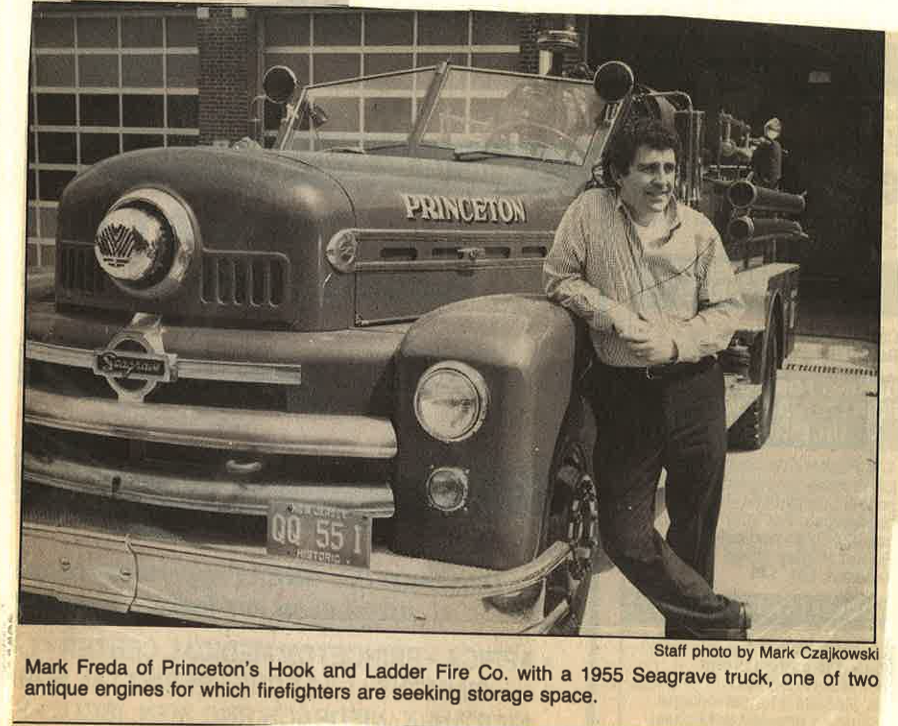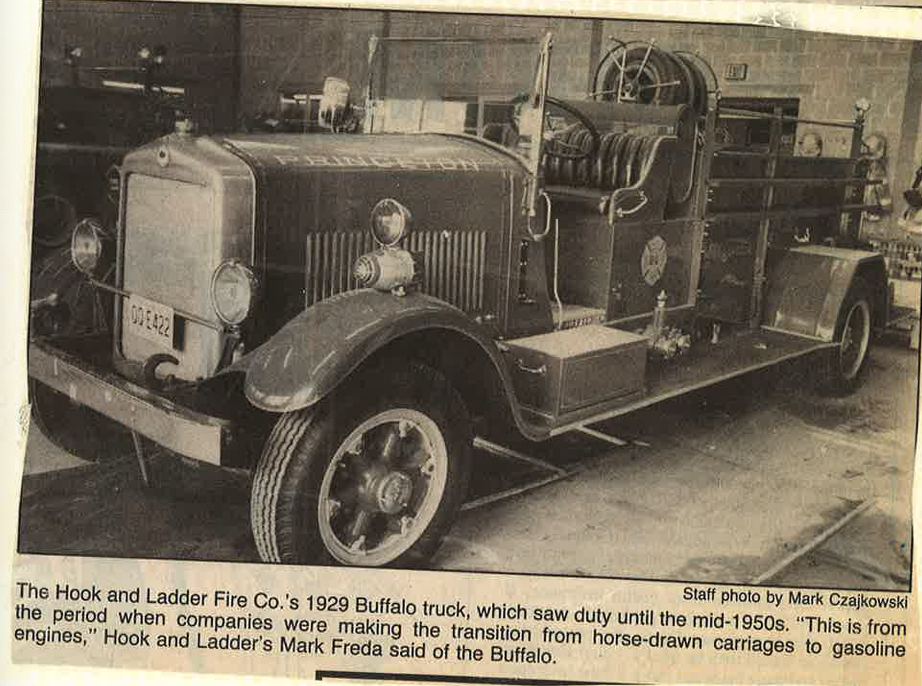
April 19, 1994
Firefighters seeking to save piece of past
Hook and Ladder’s antique trucks need home
By John P. McAlpin
Staff Writer
Two antique fire trucks may be sold off like unwanted furniture at a yard sale if the Hook and Ladder Fire Co. can’t find a new home for them by July.
Both trucks — a 1929 Buffalo and a 1955 Seagrave — served the fire company for decades. But they were replaced with bigger, faster and stronger models of pumper trucks and the newer trucks got the space in the garage. “These two trucks represent a lot of time and effort over the years by a lot of people and it would be a shame to lose that,” said Mark Freda, a member of the Hook and Ladder company since 1974.
He and firefighter Henry Tamasi are not only seeking a place to store the two fire engines. but donations that can be used to restore the older truck and to help keep the newer one running.
“It’s tough to preserve history, but really that’s what we’re trying to do here. It’s a part of Prince-ton, a part of firefighting in this town, that we’re trying to save,” said Mr. Freda, who also is a Princeton Borough Council member.
The two fire engines sit in borrowed space at the new fire-house on Witherspoon Street, home to Mercer Engine Co. No. 3. But Princeton’s rescue squad needs the space to store equipment it can’t accommodate at its Harrison Street building. The engines must be out by July 1. Company members are wrangling over the prospect of selling the trucks outright or keeping them and absorbing the costs of storage, maintenance and repairs.

The 1955 Seagrave runs and is used regularly in parade outings by the fire company. According to Mr. Freda, the truck needs only minor repairs to its brakes and to its carburetor.
But the 1929 Buffalo needs major repairs to the engine and drive train, he said. Because the truck’s manufacturer went out of business several years ago, parts for minor repairs must be fabricated, making any job costly, Mr. Freda said. The 65-year-old truck is special because it represents a transitional era in firefighting, he noted.
“This is from the period when companies were making the transition from horse-drawn carriages to gasoline engines,” Mr. Freda said. “It’s also special because that was a time when a lot of different companies were making firefighting equipment, unlike now when there are only a few. This is one of those trucks that if somebody doesn’t save this, we might not ever have an example of that company’s work or a truck like this one.”
Both trucks sport open cabs and have running boards used by firefighters to catch a ride. The Sea-grave could pump out 750 gallons of water per minute. Modern trucks average about 1,750.
The son of the Buffalo company’s president was a Princeton University student in 1929 when the fire company needed a new truck. He told his father, who sold the truck for what it cost him to make — $6,961.50.
The truck saw duty until the mid-1950s. It was sold to another fire company and later to a Prince-ton farming family who donated it back to Hook and Ladder in 1969.
The Seagrave was the company’s primary firefighting equipment until 1982, Mr. Freda said. Before that, the company also had a 1949 Mack engine.
“The Mack got sold by the borough in a salvage sale and it wound up somewhere in the Far East,” Mr. Freda said. “If that were to happen to these trucks, it would be a waste.”

Mark Freda of Princeton’s Hook and Ladder Fire Co. with a 1955 Seagrave truck, one of two antique engines for which firefighters are seeking storage space.

The Hook and Ladder Fire Co.’s 1929 Buffalo truck, which saw duty until the mid-1950s. “This is from the period when companies were making the transition from horse-drawn carriages to gasoline engines,” Hook and Ladder’s Mark Freda said of the Buffalo.